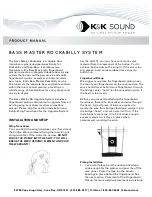
Eco Sensors
Ozone Analyzer, Model UV-100
22
Division of KWJ Engineering Inc.
User Manual, Rev. 2.0
[email protected] or (800) 472-6626
Ozone is measured based on the attenuation of light passing through a 6.2 cm long absorption cell
fitted with quartz windows. A low-pressure mercury lamp is located on one side of the absorption cell,
and a photodiode is located on the opposite side of the absorption cell. The photodiode has a built-in
interference filter centered on 254 nm, the principal wavelength of light emitted by the mercury lamp. An
air pump draws sample air into the instrument at a flow rate of approximately 1 L/min. A solenoid valve
switches so as to alternately send this air directly into the absorption cell or through an Ozone scrubber
and then into the absorption cell. The intensity of light at the photodiode is measured in air that has
passed through the Ozone scrubber (
Io
) and air that has not passed through the scrubber (
I
). Ozone
concentration is calculated from the measurements of
Io
and
I
according to the Beer-Lambert Law:
Where
l
is the path length (6.2 cm) and
σ
is the absorption cross section for ozone at 254 nm (1.15 x
10-17 cm2 molecule-1 or 308 atm-1 cm-1), which is known with an accuracy of approximately 1%. The
Eco Sensors instrument uses the same absorption cross section (extinction coefficient) as used in other
commercial instruments.
The logarithm of equation 1 is approximated in the microprocessor of the instrument with sufficient
accuracy to provide five orders of dynamic range; ozone mixing ratios are measured up to 1,000 ppmv,
as compared to 1 ppmv for most commercial ozone instruments.
The pressure and temperature within the absorption cell are measured so that the ozone concentration
can be expressed as a mixing ratio in parts-per-million by volume (ppmv).
In principle, the measurement of ozone by UV absorption requires no external calibration; it is an
absolute method. However, non-linearity of the photodiode response and electronics can result in a
small measurement error. Therefore, each instrument is compared with a NIST-traceable standard
ozone spectrophotometer in the laboratory over a wide range of ozone mixing ratios. These results are
used to calibrate the Ozone Monitor with respect to an offset and slope (gain or sensitivity). Calibration
data is supplied with the instrument. It is recommended that the instrument be recalibrated at least once
every year and preferably more frequently. The offset may drift due to temperature change or chemical
contamination of the absorption cell. An accurate offset correction can be measured from time to time
using the ozone scrubber ("zero ozone filter") available for use with the instrument.
IMPORTANT NOTE: The calibration of the UV-100 is pressure (P) and temperature (T) compensated.
Many other UV analyzers on the market are not P and T compensated even though their calibration is
certified as traceable to an international standard. The major difference that will be observed from the
lack of P and T compensation is at high altitudes the UV-100 will read a higher ozone concentration
inversely proportional to the barometric pressure at the higher altitude versus the barometric pressure
at sea level. A convenient formula for approximating the correction for Ozone analyzers other than the
UV-100 is: For every 1,000 meters of altitude, add 14% to the uncorrected reading or for every
1,000 feet of altitude, add 5% to the uncorrected reading.

































